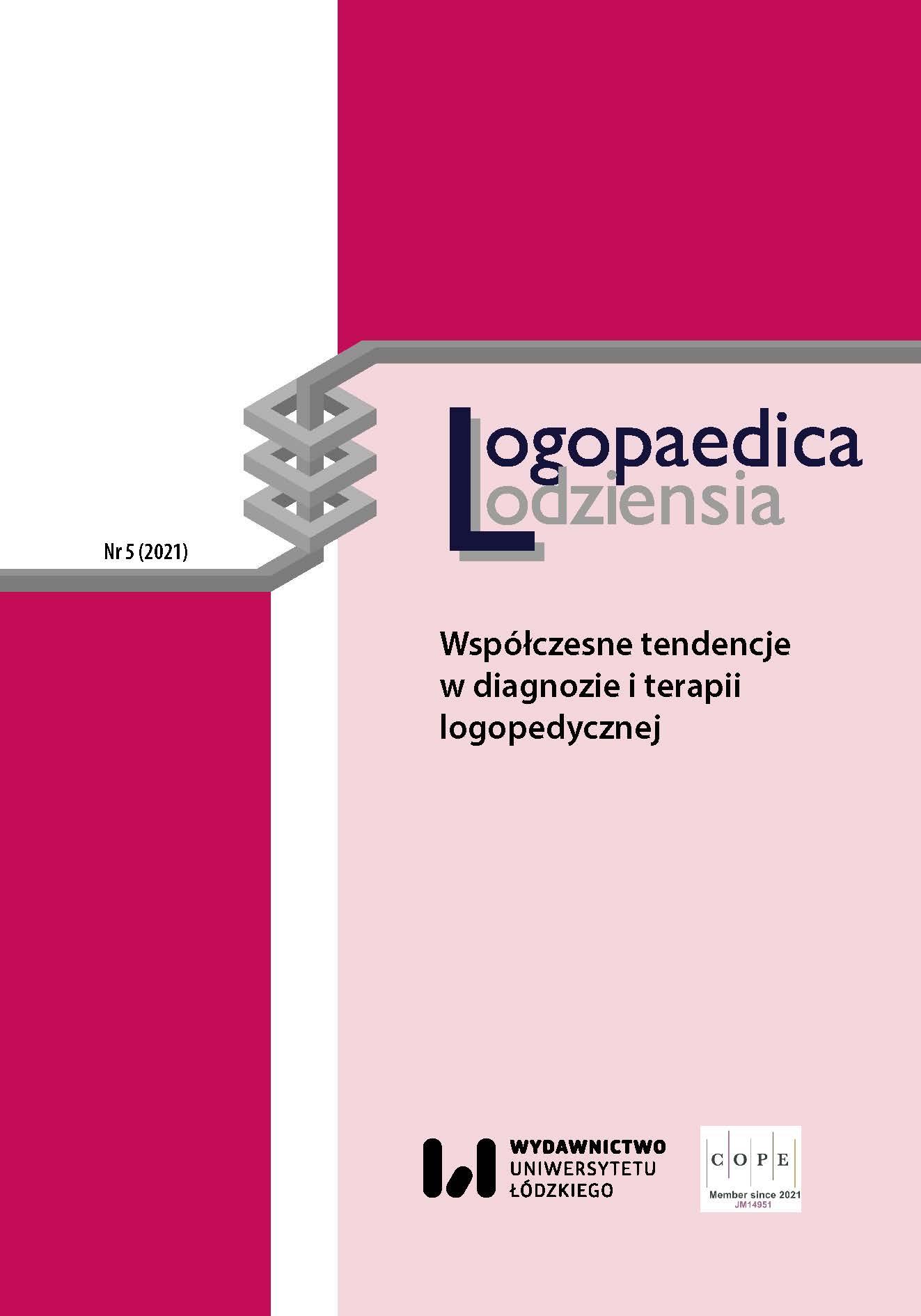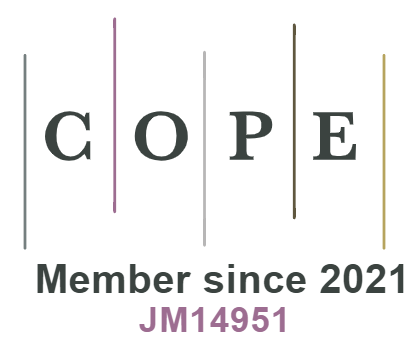Speech Therapy Assessment of a 6-Month-Old Infant with DiGeorge Syndrome
DOI:
https://doi.org/10.18778/2544-7238.05.02Keywords:
DiGeorge syndrome, infant, speech therapy diagnosis, primary activities, communication skillsAbstract
DiGeorge’s syndrome is a set of congenital defects and abnormalities caused by a deletion of chromosome 22 (loss of a fragment of the long arm of this chromosome). The symptoms of the disease include, but are not limited to: heart defects, hypocalcaemia, decreased level of calcium in the body), immune disorders, as well as facial dysmorphism, irregularities in the structure of the palate, decreased muscle tone, abnormalities in cognitive development, hearing loss, speech disorders. Patients with this diagnosis require multi-specialist care, including speech therapy. The article presents the results of the diagnosis of primary speech activities, the auditory responses and also communication and social skills of a 6-month-old child with DiGeorge syndrome, as well as the therapeutic recommendations formulated on its basis.
Downloads
References
Bogudzińska I., Woźniak T., 2013, Kwestionariusz wczesnej diagnozy logopedycznej (KWDL): propozycja diagnozy dzieci w przedziale wieku od 6. do 36. miesiąca życia, „Logopedia”, nr 42, s. 203–214.
Google Scholar
Cancrini C., Puliafito P., Digilio C., Soresina A., Martino S., Rondelli R., Consolini R., Ruga E. M., Cardinale F., Finocchi A., Romiti M. L., Martire B., Bacchetta R., Albano V., Carotti A., Specchia F., Montin D., Cirillo E., Cocchi G., Trizzino A., Bossi G., Milanesi O., Azzari C., Corsello G., Pignata C., Aiuti A., Pietrogrande M. C., Marino B., Ugazio A. G., Plebani A., Rossi P., 2014, Clinical Features and Follow-Up in Patients with 22q11.2 Deletion Syndrome, „Journal of Pediatrics”, vol. 164(6), s. 1475–1480.
Google Scholar
DOI: https://doi.org/10.1016/j.jpeds.2014.01.056
Cieszyńska J., Korendo M., 2008, Wczesna interwencja terapeutyczna. Stymulacja rozwoju dziecka od noworodka do 6 roku życia, Kraków: Wydawnictwo Edukacyjne.
Google Scholar
Cywińska-Bernas A., Paśnik J., Szałowska D., Pilarz E., 2018, Psycho-social problems in patients with 22q11.2 deletion syndrome – according to subjective evaluation by parents, „Family Medicine and Primary Care Review”, vol. 20(2), s. 117–123.
Google Scholar
DOI: https://doi.org/10.5114/fmpcr.2018.76453
Fomin A. B.F., Pastorino A. C., Kim C., Pereira C. A., Carneiro-Sampaio M., Abe-Jacob C. M., 2010, DiGeorge Syndrome: a not so rare disease, „Clinics”, vol. 65(9), s. 865–869.
Google Scholar
DOI: https://doi.org/10.1590/S1807-59322010000900009
Gacka E., 2016, Diagnoza logopedyczna noworodka i niemowlęcia, „Interdyscyplinarne Konteksty Pedagogiki Specjalnej”, nr 14, s. 13–28.
Google Scholar
DOI: https://doi.org/10.14746/ikps.2016.14.03
Gacka E., 2017, Czynniki ryzyka wystąpienia nieprawidłowości w kształtowaniu się mowy u dzieci urodzonych przed terminem (wcześniaków) w świetle założeń profilaktyki logopedycznej, [w:] D. Pluta-Wojciechowska, B. Sambor (red.), Współczesne tendencje w diagnozie i terapii logopedycznej, Gdańsk: Wydawnictwo Harmonia Universalis, s. 191–202.
Google Scholar
Gacka E., 2019, Podejście interakcyjne rodzic – dziecko w terapii opóźnień rozwoju mowy, „Logopedia”, nr 48(2), s. 261–275.
Google Scholar
Gacka E., 2020, Secondary speech therapy prophylaxis aimed at children with low birth weight – a part of research, „Interdyscyplinarne Konteksty Pedagogiki Specjalnej”, nr 30, s. 109–123.
Google Scholar
DOI: https://doi.org/10.14746/ikps.2020.30.06
Grygieńczo-Raźniewska E., Studniak E., Zajączek S., 2008, Rodzicielskie uwarunkowania zespołów delecji 22q11.2, „Pediatria Polska”, nr 83, s. 513–521.
Google Scholar
DOI: https://doi.org/10.1016/S0031-3939(08)70216-6
Homans J. F., Tromp I. N., Colo D., Schlösser T. P.C., Kruyt M. C., Deeney V. F.X., Crowley T. B., McDonald-McGinn D. M., Castelein R. M., 2018, Orthopaedic manifestations within the 22q11.2 Deletion syndrome: A systematic reviews, „American Journal of Medical Genetics”, vol. 176(10), s. 2104–2120.
Google Scholar
DOI: https://doi.org/10.1002/ajmg.a.38545
ICD-10, Międzynarodowa statystyczna klasyfikacja chorób i problemów zdrowotnych, 2008, Rewizja 10, t. I.
Google Scholar
Kluj P., Gaszyński T., 2014, Różnicowanie wybranych odrębności anatomicznych i fizjologicznych dziecka w stanie zagrożenia życia, terminologia, drogi oddechowe, oddychanie, „Ostry Dyżur”, t. 7, nr 2, s. 69–72.
Google Scholar
Lackey A. E., Muzio M. R., 2020, DiGeorge Syndrome https://www.ncbi.nlm.nih.gov/books/NBK549798 (dostęp: 24.09.2020).
Google Scholar
Łada A., 2012, Czynniki rokownicze rozwoju mowy w okresie prelingwalnym w świetle koncepcji neurorozwojowej, „Forum Logopedyczne”, nr 20, s. 56–72.
Google Scholar
Machoś M., 2013, Uwagi o ważności wczesnej diagnozy neurologopedycznej, „Logopedia Silesiana”, nr 2, s. 84–100.
Google Scholar
Masgutowa S., Regner A., 2009, Rozwój mowy dziecka w świetle integracji sensomotorycznej, Wrocław: Wydawnictwo Continuo.
Google Scholar
Olszanowski A., Białkowski J., Szkutnik M., 2003, Częstość występowania ubytków przegrody międzykomorowej oraz ich samoistnego zamykania się u dzieci, „Folia Cardiologica”, t. 10, nr 6, s. 785–790.
Google Scholar
Paśnik J., Cywińska-Bernas A., Piotrowicz M., 2007, Zespół mikrodelecji 22q11.2 – zagadnienia immunologiczne, „Postępy Higieny i Medycyny Doświadczalnej”, nr 61, s. 361–368.
Google Scholar
Pluta-Wojciechowska D., 2011, Mowa dzieci z rozszczepem wargi i podniebienia, Kraków: Wydawnictwo Naukowe Uniwersytetu Pedagogicznego.
Google Scholar
Porayski-Pomsta J., 2015, O rozwoju mowy dziecka. Dwa studia, Warszawa: Dom Wydawniczy ELIPSA.
Google Scholar
Skoczyńska M., Lehman I., 2017, Zespół mikrodelecji 22q11.2 jako problem wielodyscyplinarny, „Pediatria i Medycyna Rodzinna”, nr 13(4), s. 439–449.
Google Scholar
DOI: https://doi.org/10.15557/PiMR.2017.0047
Stecko E., 2013, Logopedia małego dziecka, Legionowo: Wydawnictwo ES.
Google Scholar
Yoo D. Y., Kim H. J., Cho K. H., Kwon E. B., Yoo E.-G., 2017, Delayed diagnosis of 22q11 deletion syndrome due to late onset hypocalcemia in a 11-year-old girl with imperforated anus, „Annals of Pediatric Endocrinology & Metabolism”, vol. 22(2), s. 133–138.
Google Scholar
DOI: https://doi.org/10.6065/apem.2017.22.2.133
Downloads
Published
How to Cite
Issue
Section
License

This work is licensed under a Creative Commons Attribution-NonCommercial-NoDerivatives 4.0 International License.












